Understanding Low Methane Cows and Their Impact

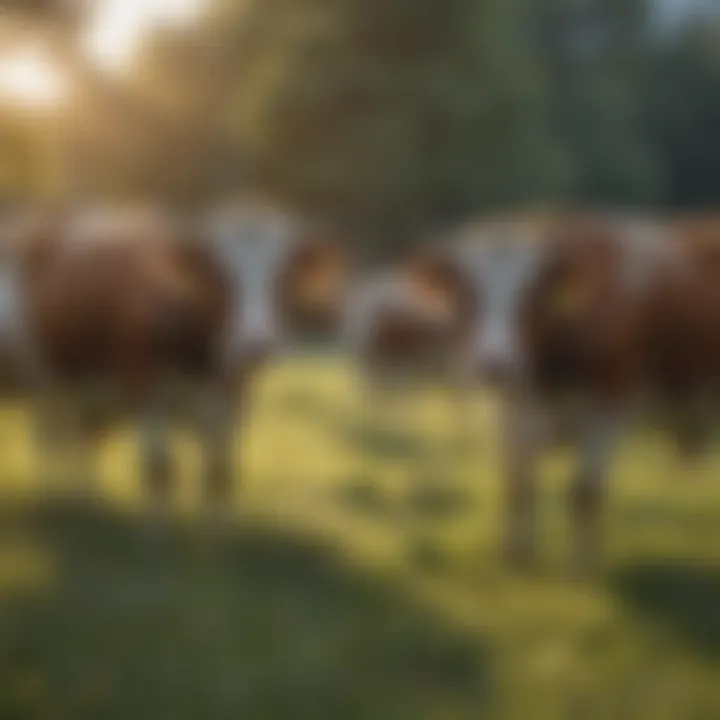
Overview of Research Topic
Brief Background and Context
Agricultural practices are often scrutinized for their environmental impact, particularly in terms of greenhouse gas emissions. Methane is a significant contributor to climate change and is generated by ruminant livestock during digestion. Traditional cattle emit considerable amounts of methane, thus raising concerns about the sustainability of livestock farming. This has led researchers to investigate low methane cows, which have potential implications for sustainable agriculture.
Importance in Current Scientific Landscape
The importance of low methane cows cannot be understated. As nations strive to meet climate goals, reducing methane emissions becomes crucial. Innovation in breeding and feeding strategies opens the door to more environmentally friendly livestock. Understanding the scientific principles behind methane production in cows is essential for developing efficient mitigation strategies. This topic is increasingly relevant, given the pressures from climate change and public demand for sustainable practices in agriculture.
Methodology
Research Design and Approach
The research in this area typically employs a combination of field studies, laboratory experiments, and genetic analysis to assess methane emissions from cattle. These methodologies offer insights into how specific breeds perform concerning methane output and how dietary changes can influence these emissions. The research often focuses on both direct measurements of methane and modeling techniques to predict future outcomes based on different strategies.
Data Collection Techniques
Data collection varies widely but commonly includes:
- Direct Measurements: Using respiration chambers or open-circuit systems to measure methane emissions under controlled conditions.
- Feeding Trials: Conducting trials with different feed types to observe their effects on methane production.
- Genetic Analysis: Studying the genomes of low-emission cattle to identify traits that could be selected for in breeding programs.
This approach allows researchers to create a comprehensive picture of what influences methane emissions and how we can breed and feed cattle more sustainably.
"Adopting low methane cattle not only helps in reducing greenhouse gases but also aligns farming practices with societal expectations for environmental responsibility."
Understanding these components will provide a solid foundation for exploring the broader implications of low methane cattle on sustainable agriculture.
Intro to Low Methane Cows
The emergence of low methane cows marks a significant evolution in agricultural practices aimed at sustainability. As the agricultural sector grapples with the pressing issue of climate change, a critical examination of livestock management practices becomes essential. Low methane cows represent not only a potential solution to reducing greenhouse gas emissions but also an opportunity to shift the paradigm of traditional cattle farming. The benefits of adopting these practices are manifold, impacting environmental, economic, and societal dimensions.
It is important to recognize the implications of methane production in livestock. Cattle are known to produce substantial amounts of methane, primarily during digestion. This greenhouse gas contributes significantly to global warming, making it imperative to explore methods to mitigate its release. By focusing on low methane cow initiatives, we can collectively work toward minimizing the environmental footprint of agriculture. This section aims to define what low methane cows are, emphasizing their role in fostering a more sustainable agricultural ecosystem.
Defining Low Methane Cows
Low methane cows are breeds of cattle that naturally produce less methane than conventional breeds. This reduced methane emission stems from a combination of genetic factors and specific dietary practices. For instance, certain breeds, like the Angus and some Asian breeds, show lower methane production levels due to their unique digestive processes. Additionally, researchers are exploring selective breeding techniques to enhance these traits further.
In essence, defining these cows involves understanding their biological characteristics and how they differ from ordinary breeds. Low methane varieties play a crucial role in promoting environmental sustainability, thereby reshaping perceptions of livestock farming in the context of climate action.
The Importance of Methane Reduction
Mitigating methane emissions is crucial, given that this gas is notably more potent than carbon dioxide in terms of its greenhouse effect. Current research indicates that livestock, especially cattle, are substantial contributors to these emissions. By focusing on low methane cows, farmers can actively participate in climate change mitigation efforts, impacting both the agricultural sector and the broader environment.
Here are some pivotal reasons regarding the importance of methane reduction in agriculture:
- Climate Change Mitigation: Each reduction in methane emissions can significantly contribute to global warming prevention efforts.
- Economic Efficiency: Agriculture can become more sustainable and economically efficient by reducing the methane footprint.
- Healthier Livestock: Lower methane-producing breeds often have enhanced overall health and productivity, leading to better quality products.
- Consumer Perception: As consumers become increasingly environmentally conscious, low methane livestock could lead to improved marketability.
Investing in low methane cows is not just an initiative for immediate gains, but it is also a strategic approach toward long-term sustainability and resilience in agriculture. Understanding these concepts is essential as we seek innovative solutions to one of the most pressing environmental challenges of our time.
Methane Production in Livestock
Understanding methane production in livestock is crucial in addressing agricultural sustainability and climate change. Livestock, particularly cattle, are significant contributors to methane emissions through their digestive processes. Methane is a potent greenhouse gas, with a warming potential much higher than that of carbon dioxide over a short timeframe. Therefore, examining the mechanisms and contributing factors behind methane production in livestock is essential for developing effective strategies to mitigate these emissions. This section discusses the biological mechanisms behind methane production and the factors that influence these emissions, such as diet composition and animal genetics.
Biological Mechanisms of Methane Production
Methane production in livestock primarily occurs during the digestion of food, particularly fibrous plant materials, through a process called fermentation. This process takes place in specialized compartments of the stomach, where a diverse community of microbes plays a critical role.
Role of Microbes in Digestion
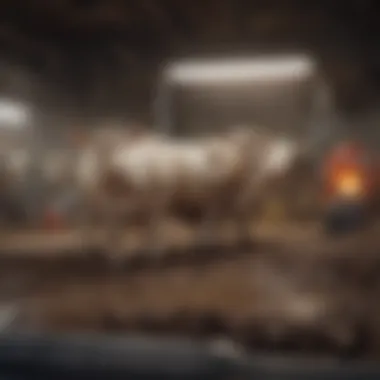
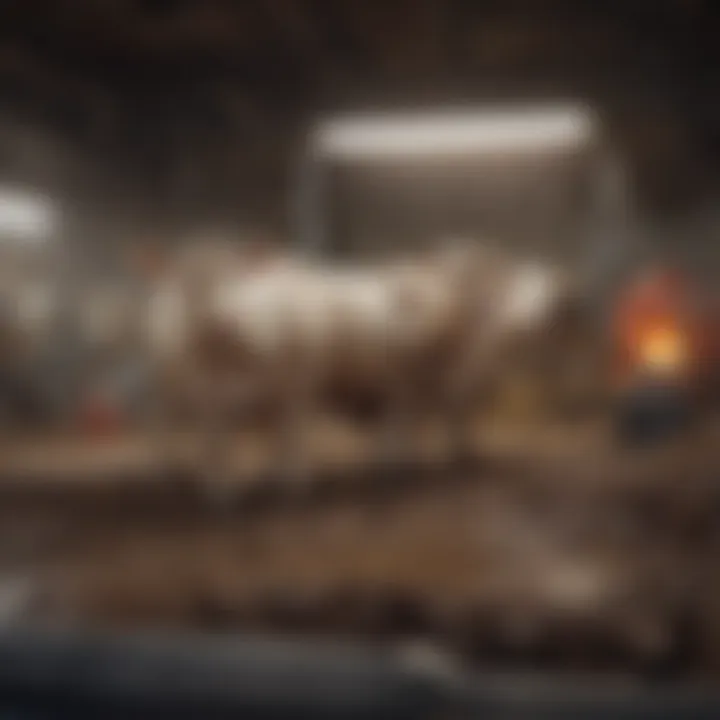
Microbes are integral to the digestion of food in ruminants like cows. These microbes break down complex carbohydrates that the livestock consume, resulting in the production of various gases, including methane. A key characteristic of these microbes is their symbiotic relationship with the host animal, helping to convert indigestible feed into energy that the animal can utilize. This partnership can be seen as beneficial for maintaining the overall health and productivity of livestock.
The unique aspect of microbial digestion is its efficiency in breaking down tough plant materials, such as cellulose. However, a disadvantage is that methane is a byproduct of this process, contributing to greenhouse gas emissions. To address this, researchers are investigating ways to modify the microbial communities in the stomachs of livestock, potentially reducing methane output while maintaining digestive efficiency.
Fermentation Processes
Fermentation is a crucial process in the digestion of livestock that leads to methane production. During fermentation, organic materials are broken down anaerobically, leading to the formation of short-chain fatty acids and gases. A significant characteristic of fermentation is that it allows for energy extraction from feed that ruminants consume, which is essential for their growth and productivity.
One of the unique features of fermentation is its potential for optimization. By changing fermentation conditions or microbial populations, it may be possible to reduce methane emissions significantly. However, balancing the reduction of methane with maintaining energy output poses a challenge in the quest for sustainable agricultural practices.
Factors Influencing Methane Emissions
Various factors influence methane emissions from livestock beyond biological mechanisms. Understanding these factors offers insights into how to effectively mitigate these emissions and enhance sustainability.
Diet Composition
Diet composition is a significant determinant of methane emissions in livestock. The types of feed, their nutritional content, and digestibility impact the amount of methane produced during digestion. High-fiber diets typically lead to greater methane production compared to more easily digestible feeds. This characteristic is critical in discussions about environmentally friendly feeding practices.
Innovative feed formulations can potentially reduce methane emissions. By incorporating specific feed additives or altering the proportions of ingredients, researchers aim to minimize methane while ensuring nutritional adequacy for livestock. However, adjustments to diet can sometimes lead to lower overall feed efficiency, which must be carefully managed.
Animal Genetics
Animal genetics also plays an essential role in methane emissions. Some breeds of cattle naturally produce less methane than others due to genetic variations. This factor is fundamental for future breeding programs that aim for low-methane traits in livestock.
The unique feature of focusing on animal genetics for methane reduction is scalability. Selective breeding can enhance productivity and reduce greenhouse gas emissions without dramatic changes to management practices. However, this process requires careful genetic assessment and long-term commitments from farmers and breeders, as achieving significant changes may take generations.
Strategies for Reducing Methane Emissions
The urgency to mitigate climate change demands effective strategies for reducing methane emissions in livestock. Methane is a potent greenhouse gas, and its reduction can significantly influence agricultural sustainability. Strategies that target methane emissions from cattle not only address environmental concerns but also enhance the long-term viability of farming practices. Understanding various approaches, such as selective breeding and nutritional adjustments, can facilitate a decrease in methane output, showing promise for both ecological and economic benefits.
Selective Breeding for Low Methane Traits
Selective breeding offers a proactive strategy for reducing methane emissions. This involves identifying and breeding animals that naturally produce less methane. Research indicates that certain cattle breeds exhibit inherent genetic traits that correlate with lower methane production. By focusing on these traits—such as feed efficiency, digestive processes, and other physiological characteristics—breeders can create a herd that is better equipped to minimize greenhouse gas emissions over generations.
This approach can yield significant benefits. Besides lowering methane emissions, selective breeding can also enhance overall animal health and productivity. Cattle that utilize feed more efficiently can translate into cost savings for farmers. Nonetheless, breeders must navigate challenges such as the long time frame for achieving noticeable results and maintaining genetic diversity within herds.
Nutritional Approaches
Nutritional strategies play a crucial role in managing methane emissions. Altering the diet of cattle can significantly impact their methane production during digestion. Focusing on high-quality feeds can lead to a reduction in emissions while also improving the health and productivity of livestock.
Additives and Supplements
Feed additives and supplements represent an important avenue within nutritional approaches. These substances can be included in cattle diets to directly inhibit methane-producing microbes in the stomach. Common additives include seaweed, tannins, and other biological agents. Recent studies have shown that using seaweed, in particular, can reduce methane emissions by up to 80%, making it a popular choice for many farmers looking for immediate results.
The key characteristic of these additives is their ability to mitigate fermentation processes that lead to methane. This unique feature presents not only a potential path for emissions reduction but also an opportunity for enhancing cattle productivity. However, there are some disadvantages, such as the cost of certain supplements and possible variations in effectiveness depending on local conditions and feeding practices.
Modified Grazing Practices
Modified grazing practices are another vital element in reducing methane emissions. Adjusting grazing patterns can optimize the health of pastures and improve the digestibility of forage. Practices include rotational grazing, which allows for better pasture recovery and enhances the quality of grasses available to cattle.
The distinct advantage of modified grazing lies in its ability to integrate environmental stewardship with livestock management. It promotes richer ecosystems, which can support higher-quality feed and indirectly lead to lower methane emissions. However, some challenges include the need for greater management and understanding of pasture dynamics, which may require additional resources and labor.
"Emphasizing nutritional strategies and exploiting genetic potential can decisively impact the reduction of methane emissions in livestock."
These combined efforts represent a pathway toward more sustainable livestock management, enhancing both environmental and economic aspects of farming.
Environmental Impact of Low Methane Cows
The integration of low methane cows into agricultural practices can lead to significant environmental benefits. These animals play a critical role in addressing some pressing issues related to climate change, particularly methane emissions. As a potent greenhouse gas, methane has a far greater warming potential compared to carbon dioxide over a shorter timeframe. Thus, reducing methane emissions from livestock is crucial for sustainability in the agricultural sector. The focus on low methane cows not only aims at helping farmers improve productivity but also emphasizes ecological balance and health.
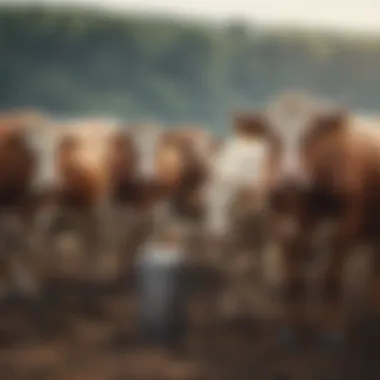
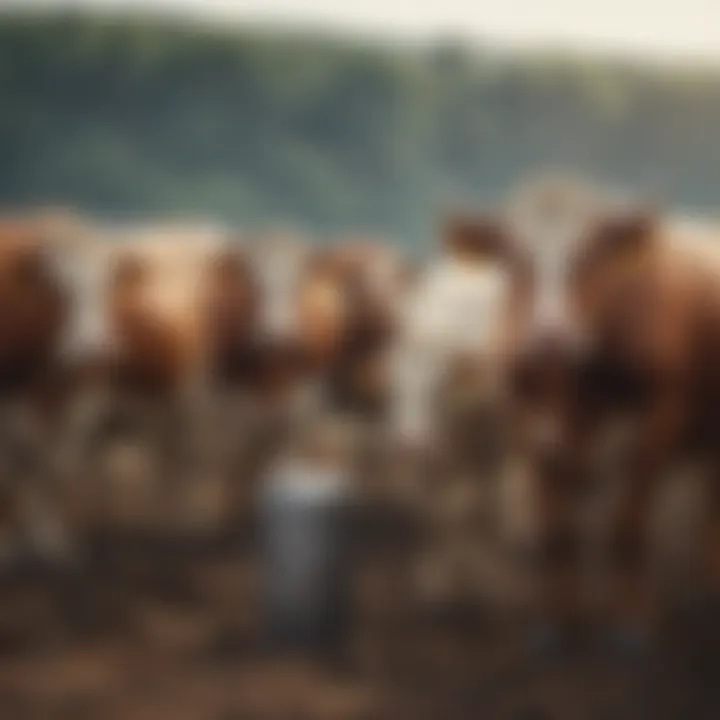
Contribution to Climate Change Mitigation
One of the primary advantages of low methane cows is their potential to mitigate climate change. Methane emissions from traditional cattle rearing can severely contribute to global warming. Research indicates that livestock farming is responsible for a considerable percentage of total anthropogenic methane emissions. By promoting low methane traits through selective breeding and nutritional strategies, it is possible to lower these emissions substantially.
Key Benefits of Low Methane Cows Include:
- Lower Greenhouse Gas Emissions: By producing less methane, low methane cows reduce the overall carbon footprint of livestock farming.
- Enhanced Carbon Sequestration: Healthy pastures that support low methane cattle also absorb more carbon dioxide, enhancing soil health.
- Alignment with Climate Goals: The use of low methane cows can help meet international climate agreements, including targets set by the Paris Agreement.
"Focusing on low methane cows is not simply an agricultural trend; it's a response to a pressing global challenge."
Ripple Effects on Ecosystems
Adoption of low methane cows can yield positive ripple effects on surrounding ecosystems. These cows can potentially enhance biodiversity and improve soil quality. This improvement results from a more efficient grazing system where low methane cows are better integrated into rotational grazing practices. Furthermore, healthy livestock contributes to vibrant ecosystems, fostering a balance among various species.
The following points underline these ecosystem benefits:
- Biodiversity Conservation: With better grazing management, low methane cows can help maintain diverse plant and animal species.
- Soil Health Improvement: Healthier cows lead to improved nutrient cycling, reduced erosion, and enhanced soil fertility, which is essential for sustainable agriculture.
- Water Quality Protection: Efficient grazing limits overgrazing, reducing runoff and pollutants in nearby water sources.
In summary, incorporating low methane cows offers a multi-faceted solution to environmental challenges. By addressing methane emissions and promoting ecosystem health, low methane cattle provide a viable strategy for sustainable agriculture and climate change mitigation.
Economic Considerations
Economic considerations play an essential role in the adoption of low methane cows within agriculture. As stakeholders increasingly recognize the impact of livestock on climate change, understanding the economic implications becomes vital. Reducing methane emissions can have financial benefits for farmers, enhance food security, and align agricultural practices with environmental sustainability. These considerations are not just about immediate savings but encompass long-term investments in technology and practices that can ensure viability and profitability.
Cost-Benefit Analysis of Low Methane Practices
A cost-benefit analysis provides a clear framework for farmers to evaluate the economic feasibility of implementing low methane practices. The analysis encompasses various factors, including:
- Initial Investment: Costs related to breeding programs or feed additives may present a barrier initially. However, these costs must be weighed against long-term gains.
- Operating Costs: Lower methane emissions can lead to improved animal health and productivity, which may decrease overall operating costs. Healthier cows often require less veterinary care.
- Market Premium: There is growing consumer demand for products from low methane sources. Farmers may capitalize on this by receiving premium prices for low-impact meat and dairy products.
- Subsidies and Grants: Various regions offer financial assistance for implementing sustainable practices. This can significantly offset initial investments, making the transition more feasible.
A thorough cost-benefit analysis helps farmers understand that investing in low methane practices can offer significant returns over time.
Evaluating these factors provides insights into the economic viability of low methane cattle and guides farmers in strategic decision-making.
Market Opportunities and Challenges
The shift towards low methane cows also opens new market opportunities, though challenges persist. On the opportunity side:
- Consumer Awareness: Increased levels of consumer awareness regarding climate issues encourage demand for sustainable products. This provides avenues for farmers to market low methane products successfully.
- Retail Partnerships: Retailers are beginning to seek out sustainable sources for their meat and dairy. Establishing partnerships with these retailers can yield financial benefits.
- Innovative Products: There is potential for creating innovative products that appeal to environmentally-conscious consumers, expanding market segments.
Despite these opportunities, challenges do exist:
- Market Education: A primary challenge is educating the consumers on the benefits of low methane products. Without adequate understanding, the market growth may be limited.
- Change Resistance: Some farmers may resist changing established practices due to uncertainty regarding results or perceived risks associated with new methods.
- Regulatory Hurdles: Policies relating to environmental practices can vary significantly. Staying abreast of regulatory changes can be burdensome for farmers.
Navigating these market opportunities and challenges requires a comprehensive approach that combines innovation with strategic planning to maximize the benefits of low methane cattle.
Societal Acceptance of Low Methane Cattle
The concept of low methane cows is not solely a scientific or agricultural issue but also a societal one. The acceptance of low methane cattle within communities can significantly influence their adoption and integration into mainstream farming practices. Without public backing, even the most innovative and effective strategies may face obstacles.
Understanding how society perceives these cattle can provide insight into the barriers and opportunities present for the agriculture sector. Several elements affect societal acceptance, including awareness of agricultural practices, understanding of environmental impacts, and the perception of farmers' roles in climate change mitigation.
Public Perception and Concerns
Public perception of low methane cattle hinges on various factors. One major aspect is people's understanding of methane as a greenhouse gas. While awareness of climate change is increasing, many individuals do not recognize livestock as a substantial source of methane emissions. This gap in knowledge can lead to skepticism about the effectiveness of low methane initiatives.
Additionally, the public may express concerns about the potential impacts of selective breeding on animal welfare. It is crucial to communicate that the objective of breeding low methane cattle is to ensure health benefits alongside environmental goals. The agricultural community must strive for transparency in their processes, highlights benefits for both the cows and the environment.
Funding and financial incentives can also play a role in shaping public opinion. If people believe that farmers will benefit economically from adopting low methane practices, they may be more likely to support these changes. Further clarity is needed on how low methane practices contribute to profitability and sustainability.
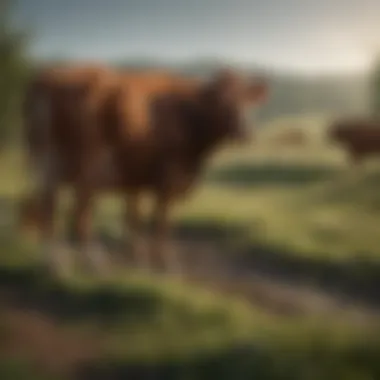
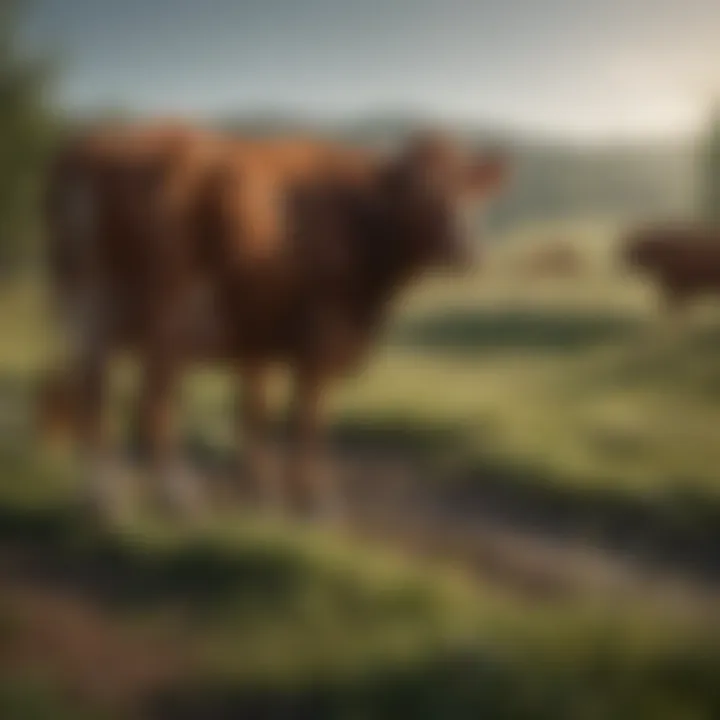
"To make progress on climate change, we must address societal barriers to embracing innovative practices in agriculture."
Policy and Regulation Implications
The regulatory environment surrounding agriculture has a significant impact on low methane cattle. Policymakers must understand the scientific underpinnings and benefits associated with these cattle. Regulations that incentivize low methane practices can shape public acceptance positively. These may include subsidies for farmers transitioning to low methane systems, tax breaks, or grants for research and implementation.
Policies that outline clear standards for methane emissions and promote sustainable agriculture practices can bolster the credibility of low methane cattle programs. In addition, collaboration between governments, educational institutions, and agricultural businesses is necessary to develop effective, science-based regulations that encourage acceptance.
Ultimately, societal acceptance of low methane cattle hinges upon education and communication. Addressing public concerns and demonstrating the benefits of these practices can pave the way for a smoother transition to sustainable agriculture. Engaging the public through information campaigns can help in building a foundation of trust and understanding, critical for the ongoing success of low methane initiatives.
Future Research Directions
As agriculture stands at the crossroads of sustainability and innovation, the potential of low methane cows emerges as a pivotal research area. Understanding the genetic and nutritional factors influencing methane production can lead to significant breakthroughs in livestock management. Identifying low methane traits in cattle can enhance the efficiency of beef and dairy production while minimizing greenhouse gas emissions. Here, the alignment of scientific inquiry and practical application becomes crucial to advancing sustainable practices in farming.
Innovative Technologies in Selective Breeding
Selective breeding has the ability to drastically alter methane emissions in cows. Recent advancements in genomics offer new opportunities for identifying cattle with lower methane production characteristics. The application of genome editing technologies, such as CRISPR, can enhance the precision in breeding programs. Through this method, specific genes associated with methane emissions can be targeted, allowing farmers to breed cattle that naturally emit less methane.
Moreover, the integration of data from genomic sequencing and phenotypic analysis is key. By analyzing traits such as feed efficiency and microbial profiles within the digestive system, breeders can make informed decisions regarding livestock selection.
- Benefits of Innovative Technologies in Selective Breeding:
- Reduction of methane emissions
- Improved feed conversion ratios
- Enhanced genetic diversity
While these strategies show promise, ethical considerations surrounding genetic manipulation must also be addressed. As scientific communities explore these innovative pathways, ongoing assessment of long-term effects on animal welfare remains essential.
Exploring New Feed Additives
The role of nutrition in shaping methane emissions cannot be dismissed. Research into feed additives presents exciting possibilities. Substances like seaweed and tannins have demonstrated potential in inhibiting methane production during digestion. Feeding strategies that include these additives can lead to substantial reductions in greenhouse gas emissions.
The mechanism by which these feed additives operate is primarily centered on altering microbial fermentation in the rumen. For example, red seaweed, when included in the diet, has shown a 70% reduction in methane emissions due to its bioactive compounds. This kind of research is not only impactful for the environment but also for the livestock industry, which is always on the lookout for productive feed solutions.
- Considerations in Feed Additive Research:
- Effectiveness across different cattle breeds
- Cost implications for farmers
- Long-term health effects on livestock
The promise of feed additives is evident, but rigorous testing is needed to ensure that the benefits outweigh potential risks. Future studies must focus on the sustainability of these additives in different climates and farming practices.
The End
The exploration of low methane cows and their significance in sustainable agriculture is pivotal for those seeking answers in the challenges related to climate change and environmentally-friendly farming practices. This article highlighted specific elements that contribute to the understanding of low methane production in livestock and its broader implications on agriculture and the environment.
One notable advantage of focusing on low methane cattle is the potential for substantial reduction in greenhouse gas emissions. Methane is a potent greenhouse gas, and its reduction from livestock production can lead to significant improvements in air quality and climate stability.
Moreover, the adoption of low methane farming practices brings forth economic benefits. Farmers can experience enhanced productivity and potentially lower feed costs by integrating selective breeding and innovative dietary strategies. The downstream effects on market dynamics could also open new opportunities within agricultural sectors focusing on sustainability.
Another critical aspect this article examined is the societal acceptance of low methane cattle. Understanding public perception is essential for the successful implementation of these practices. Policies and regulations should support efforts to promote sustainable agricultural practices, which includes the integration of low methane cows into farming systems.
Emphasizing the importance of future research is essential as well. Innovative technologies in selective breeding and the exploration of novel feed additives could yield additional improvements in methane emissions reductions. Continuous research ensures that farmers and the scientific community stay ahead of emerging challenges related to livestock farming.
Importance of Citing Sources
Citing sources like peer-reviewed journals, scientific articles, and agricultural reports lends authority to the claims made throughout the article. This is essential for establishing the scientific concepts surrounding low methane cows and their role in greenhouse gas emission reduction.
- Enhances Credibility: Accurate references demonstrate the writer's diligence in research. They show that the ideas presented are rooted in proven science rather than conjecture.
- Fosters Transparency: When readers can trace the information back to its source, it builds a layer of trust. Transparency is especially vital when discussing environmental issues that affect public policy and economic considerations.
- Guides Further Research: References provide entry points for readers wishing to delve deeper. They can explore the original studies, methodologies, and results for a more nuanced understanding of the challenges and innovations in this field.
Considerations for Selecting References
When compiling references for a topic as intricate as low methane cows, certain criteria should be followed:
- Relevance: The sources should relate directly to the subject of methane production in livestock and strategies for reduction.
- Recency: Given the rapid advancements in agricultural science, it is critical to include up-to-date studies and reports.
- Diversity of Perspectives: Incorporating different viewpoints—such as those from livestock management, environmental science, and economics—enriches the discussion.
Types of References to Include
- Academic Journals: Articles from journals like Journal of Dairy Science and Livestock Science can provide rigorous empirical data.
- Government Reports: Publications from organizations like the Food and Agriculture Organization of the United Nations can offer valuable statistics and insights into policy recommendations.
- Conferences and Symposiums: Proceedings from relevant conferences often highlight the latest research and technological advancements in the area of low methane cattle.
"Well-referenced articles are typically perceived as more rigorous and reliable than those with limited citations."



